Mathematical modelling of combined pressure driven and electrokinetic effect in a channel with induced magnetic field: An exact solution
⁎Corresponding author. michaeloni29@yahoo.com (Michael O. Oni)
-
Received: ,
Accepted: ,
This article was originally published by Elsevier and was migrated to Scientific Scholar after the change of Publisher.
Peer review under responsibility of King Saud University.
Abstract
This article presents exact solution for pressure driven flow formation of electrically conducting fluid in a parallel plate channel formed by two horizontal parallel plates with electrokinetic effects and induced magnetic field. Using the Poisson–Boltzmann, Navier-Stokes equations and induction equation, the governing electric potential, momentum, induced magnetic field and energy equations for the present article are presented and transformed to their corresponding dimensionless form using suitable parameters. The governing dimensionless equations are solved exactly and graphical representation are presented. During the cause of graphical illustration, it is found that the role of electrokinetic effects and Hartmann number is to decrease the electric potential, fluid velocity, induced magnetic field and fluid temperature. A special case is found and discussed when the value of Hartmann number equals the Debye-Hückel parameter. It is interesting to note that heat transfer is independent on governing parameters for large value of Debye-Hückel parameter.
Keywords
Electrokinetics
Induced magnetic field
Pressure driven
Exact solution
Channel
Nomenclature
-
-
spacing between the parallel plates
-
-
concentration of ions in bulk fluid
-
-
electrostatic intensity
-
-
Faraday’s constant
-
-
acceleration due to gravity
-
-
dimensionless parameter
-
-
dimensional induced magnetic field
-
-
vectorial induced magnetic field
-
-
dimensionless induced magnetic field
-
-
dimensionless induced current flux
-
-
dimensionless induced current density
-
-
Hartmann number
-
-
Nusselt number
-
-
dimensionless pressure
-
-
heat flux
-
-
dimensionless heat flux
-
-
universal gas constant
-
-
dimensional temperature
-
-
ref. temperature of the fluid
-
-
axial velocity
-
-
constant ref. velocity
-
-
mean velocity
-
-
dimensionless axial velocity
-
-
vectorial velocity profile
-
-
valence number of ions in the solution
-
-
axial and transverse coordinates respectively
-
-
dimensionless axial coordinate
-
-
dimensionless transverse coordinate
-
-
dimensionless pressure gradient
-
-
fluid permittivity
-
-
(dimensionless)
-
-
zeta
-
-
electrostatic potential
-
-
externally imposed electrostatic potential
-
-
Debye-Huckel parameter
-
-
Debye length
-
-
dimensional EDL potential
-
-
dimensionless EDL potential
-
-
thermal expansion coefficient
-
-
fluid thermal conductivity
-
-
fluid dynamic viscosity
-
-
magnetic permeability
-
-
fluid density
-
-
electrical conductivity of the fluid
-
-
skin-friction
-
-
dynamic viscosity at
-
-
kinematic viscosity
-
-
fluid density
-
-
charge density
-
-
dimensionless temperature
-
-
value at the wall
-
-
value at the wall
-
-
purely electrokinetic solution
-
-
bulk value
-
-
purely pressure driven flow
-
-
special case solution
Subscripts
1 Introduction
Electrokinetic phenomenon is significant in laboratory, industrial and engineering applications such as the removal of contaminants in soil and imposing electric ion on flow formation. This phenomenon involves the passing of low-voltage direct current electric field across the boundary on a fluid. Other applications can be found in medical field for cardiopulmonary resuscitation and development of battery cells.
When a liquid containing small amount of ions is brought in contact with a solid boundary, the like charges repel while the unlike charges attract. This situation leads to the formation of EDL (electric double layer) closed to the wall containing excess counter ions. Reuss (1809) and Probstein (1994) are the earliest scientists to discover the electrokinetic effects. Reuss (1809) in an experiment on porous clay found that particles dispersed in water migrate due to the constant application of electricity. Later, Helmholtz (1879) developed the EDL theory which relates the electric and flow parameters for electrokinetics. With increasing interest in understanding electrokinetic flows, many numerical investigations have been carried out. Patankar an Hu (1998) presented numerical simulation of microfluidic injection using electroosmotic forces through intersection of two channels. Ren and Li (Debye and Hückel, 1923) studied electrosomotic flows in microchannels with axially non-uniform zeta potentials and varying cross-sections. Yang and Li (1998) used the Debye-Hückel approximation (Ren and Li, 2001) to develop a numerical algorithm for elecrokinetically-driven Newtonian liquid flows. They concluded that for a liquid solution of low ionic concentration and a solid surface of high zeta potential the liquid flow in rectangular microchannels is significantly influenced by the presence of the EDL field and hence deviates from the flow characteristics described by classical fluid mechanics.
Many researches have been committed to study the combined effect of pressure and electrokinetic effects on flow formation in channel (Zade et al., 2007; Mukhopadhyay et al., 2009; Soong and Wang, 2003; Matin and Khan, 2016). Mukhopadhyay et al. (2009) examined the fully developed hydrodynamic and thermal transport in combined pressure and electrokinetically driven flow with asymmetric boundary condition. They established that both flow and heat transfer characteristics are significantly affected by the asymmetries in wall boundary conditions for both purely electroosmotic and combined pressure-driven and electroosmotic flow.
The study of electromagnetic induction has found many applications in design of electrical appliances such as inductors, transformers, alternators, electric motors and generators. The use of a magnetic field to control the motion of an electrically conducting fluid has been investigated under different conditions: with respect to geometry of the channel in which the fluid is flowing, the nature of the conducting fluid, source of the applied magnetic field, degree of ionization of the fluid and strength of the magnetic field. Rossow (1957) examined the flow of an incompressible boundary layer over a flat plate when the magnetic field is applied transversely to the direction of flow. He found that heat transfer is reduced by the application of magnetic field. Other important applications of electromagnetic and fluid interaction include, conversion of heat energy to electrical energy, ion propulsion studies, radio wave propagation in the ionosphere and controlled nuclear fusion, protection of internal surface of channels and nozzles from high temperature and high speed fluids (Ibrahim, 1967).
In the absence of induced magnetic field, (Jha and Oni, 2017; Jha et al., 2015) analysed the significance of Hartmann number on flow formation in different geometries. In the above sited articles, this assumption is only valid for very small magnetic Reynold number. To present a precise solution, the induced magnetic field should not be neglected. In view of this, Jha and Aina (2016) studied the role of induced magnetic field on MHD natural convection flow in a vertical microchannel formed by two electrically non-conducting infinite vertical parallel plates. Other relate articles are Jha and Sani (2013) and Gosh et al (2010). Other related works on combined pressure and electrokinetic effect in the presence of uniform magnetic field carried out both numerically and experimental studies can be seen in (Das and Mitra, 2012; Ganguly, 2015; Sarkar, 2014; Sarkar and Ganguly, 2018; Sarkar et al., 2017a, b, c).
In all the mentioned articles above, to the best of authors’ findings, none of these articles have considered the induced magnetic field generated once the magnetic Reynolds number is high. This present article is aimed at investigating the combined role of induced magnetic field and electrokinetic in flow formation of an electrically conducting fluid in a conducting or non-conducting infinite parallel plates. The governing equations are developed and solve exactly, graphical and tabular represented are also presented to understand the role of basic governing parameters.
The novelty of the proposed work is to analyse the impact of induced magnetic field on flow formation and heat transfer in combined pressure and electrokinetically driven flow of conducting fluid in a horizontal channel. Furthermore, the role of conducting/ non-conducting channel walls on rate of heat transfer is extensively discussed. A similar problem is discussed by Mukhopadhyay et al. (2009) in the absence of induced magnetic field.
2 Mathematical formulation
Consider a laminar, fully developed forced convection flow of an electrically conducting, viscous, incompressible fluid in a conducting or non-conducting parallel plates channel with electrokinetic effects in the presence of transversely applied magnetic field. The
-
The flow is assumed to be driven by combined constant pressure gradient and external voltage gradient.
-
A uniform magnetic field strength
-
The plates are taken to be either conducting or non-conducting; Case I, both walls are non-conducting, Case II, the wall
-
The walls are negatively charged and the liquid contains an ideal solution of fully dissociated symmetric salt, the EDLs formed on the walls do not overlap, and the temperature variation over the channel cross section is negligible compared with the absolute temperature.
-
The charge distribution in the EDL follows Boltzmann distribution, hence the ion convection effects are negligible.
-
The wall potentials are considered low enough for Debye-Hückel linearization to be valid.
-
The external voltage is significantly higher than the flow induced voltage.
-
Except otherwise stated, all thermophysical parameters are assumed constant.
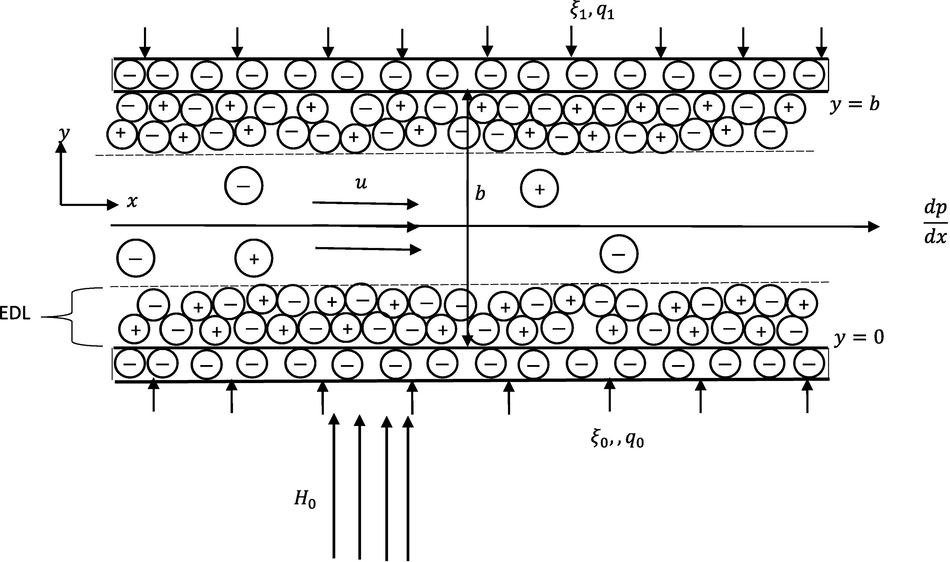
- Schematic of the problem.
2.1 Electric potential distribution
Following above assumptions, the electrical potential distribution is obtained from Poison-Boltzmann equation (Mukhopadhyay et al., 2009) as:
The potential
For fully developed flow, the external potential gradient is in the axial direction only, since the wall potentials are assumed low enough for Debye-Hückel linearization to be valid, Eq. (1) in dimensionless form becomes:
Subject to
The details of this derivation can be found in (Mukhopadhyay et al., 2009; Matin and Khan, 2016)
3 Velocity and induced magnetic field
The momentum and induced magnetic field equations are obtained from the Navier-Stokes equations and induction equation respectively as:
Considering the steady fully developed flow (
While the induced magnetic field equation is obtained from magnetic induction equation as (Gosh et al., 2010):
Using suitable dimensionless parameters, Eqs. (6–7) become:
subject to the following dimensionless boundary conditions:
Since the flow is fully developed, it is usual to assume constant pressure gradient which is obtained from the fluid conservation:
3.1 Energy equation
Due to the constant flux at the walls, the energy equation is obtained in dimensional form as (Mukhopadhyay et al., 2009)
Following (Mukhopadhyay et al., 2009), the energy equation in dimensionless form with the associated boundary conditions are given as:
The following dimensionless parameters are used in this current article, and given as follow:
It should be mentioned that in the absence of the magnetic field
3.2 Exact solution for the models
The electric potential, velocity profile, induced magnetic field, pressure gradient and temperature distributions of Eqs. (2, 8, 9, 12, 14) are solved with their corresponding boundary conditions respectively to obtain the following exact solutions:
The dimensionless skin-friction on both walls are obtained from Eq. (18) and given by:
Two important parameters for flow formation with induced magnetics field are induced current density
Another significant quantity in fluid and thermodynamics is the heat transfer coefficient. The heat transfer between the heated plats and the electrically conducting fluid is represented by Nusselt number and obtained as:
4 Results and discussion
This article investigate the combined role of transversely applied magnetic field and electrokinetic effect on pressure driven flow in a parallel plates channel with induced magnetic field.
4.1 Special cases
From the solutions obtained from Eqs. (18) – (23), a discontinuity point is observed when the Hartmann number
From the velocity and induced magnetic field, all other parameters such as temperature, skin-friction, induced flux density and Nusselt number can be obtained when the value of Hartmann number is equal to the Debye-Hückel parameter.
For purely forced convection flow, i.e.
In similar manner, for purely electrokinetic flow, the pressure gradient becomes zero
To have a clearer understanding on flow formation in the channel, graphs and tabular representations are carried out on fluid velocity, induced magnetic field, temperature distribution, skin-friction, induced current density and Nusselt number. Throughout the current research, the Debye-Hückel parameter is taken over the range of
Fig. 2 presents the combined role of Debye-Hückel parameter
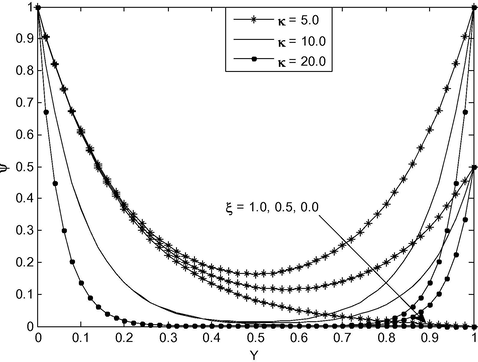
- Electrostatic potential for different values of
Fig. 3 depicts the effect of
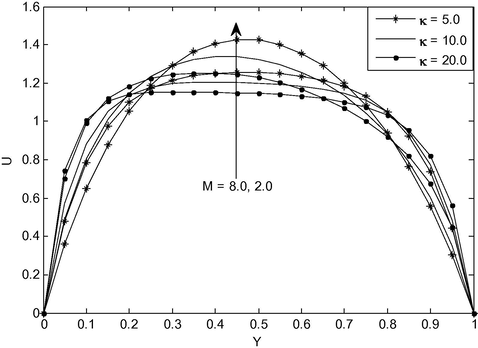
- Velocity profile for different values of
On the other hand, Fig. 4 shows the impact of zeta potential on dimensionless fluid velocity in the channel. It is obvious that fluid velocity is highest at the center of the channel for purely asymmetric wall voltage gradient
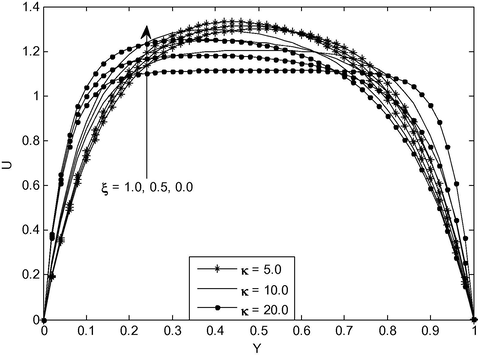
- Velocity profile for different values of
Figs. 5a, 5b and 5c portray dimensionless induced magnetic field when both walls are non-conducting, the wall
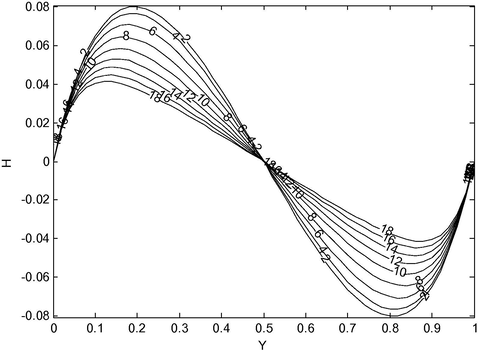
- Induced magnetic field for different values of

- Induced magnetic field for different values of
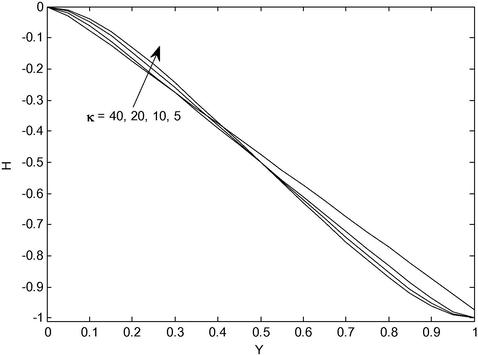
- Induced magnetic field for different values of
Figs. 6a and 6b present the combined role of Hartmann number
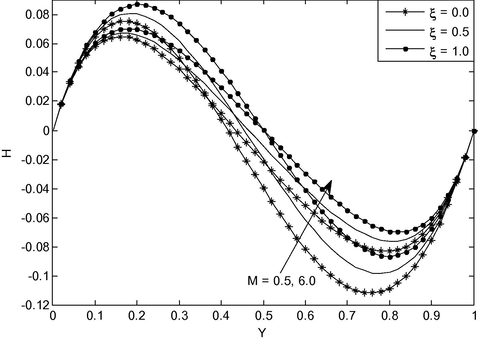
- Induced magnetic field for different values of.

- Induced magnetic field for different values of
From Fig. 6b on the other hand, induced magnetic field decreases along the plates monotonically from
The effects of Debye-Hückel parameter
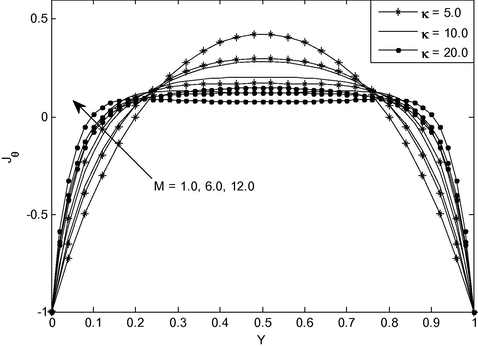
- Induced current density for different values of.

- Induced current density for different values of.
Fig. 8 gives a contour variation of temperature distributions in the channel as a function of

- Temperature distribution
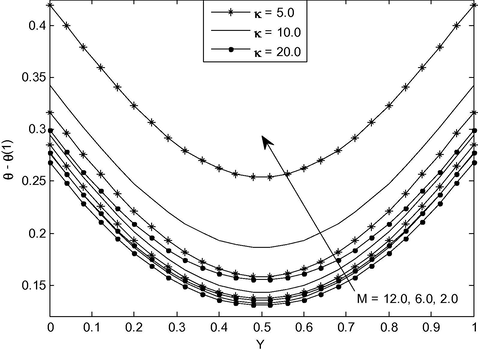
- Temperature distribution for different values of
Fig. 10 displays temperature distributions as a function of zeta potential and wall heat flux at fixed value of
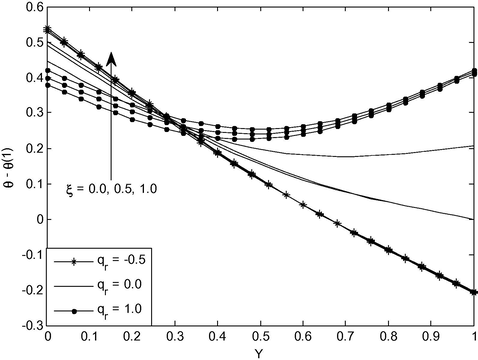
- Temperature distribution for different values
One of the important parameter in the study of fluid formation in an enclosed surface is the skin friction. It is defined as the drag force to which fluid hits the walls of the parallel plates. Figs. 11 and 12 reveal variation of skin friction with Debye-Hückel parameter

- Skin-friction for different values

- Skin-friction for different values
Fig. 11 further shows that the role of zeta potential at this surface is to decrease skin-friction while the reverse trend is observed at the wall
Over the years, there have been intense interest in understanding the rate of heat transfer between fluid and surfaces of solid object. This is due to its industrial and domestic applications. Figs. 13, 14 and 15 represent the rate of heat transfer represented by Nusselt number as a function of governing parameters. Fig. 13 depicts the significance of Debye-Hückel parameter
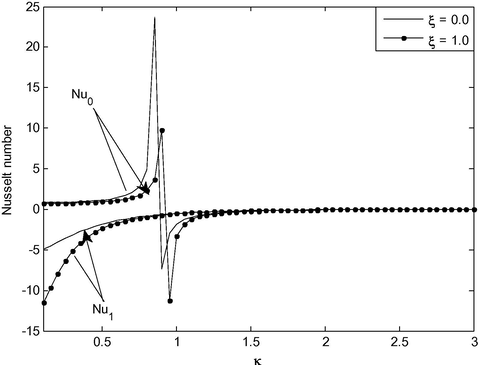
- Nusselt number for different values of
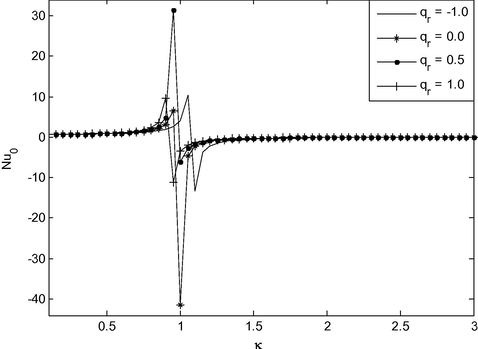
- Nusselt number for different values of
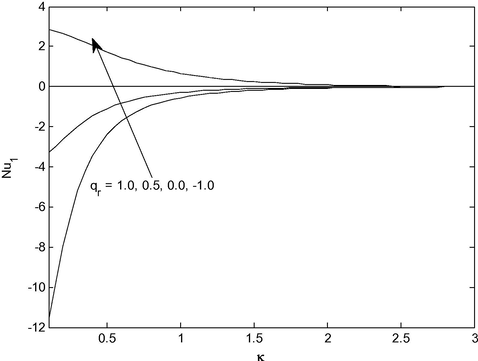
- Nusselt number for different values of
Similar trend is obtained for variation of Nusselt number with heat flux parameters at the wall
Fig. 15 on the other hand shows a monotone behaviour for variation of Nusselt number with heat flux parameter
Table 1 presents numerical computations for induced current flux
|
|
||||||
|---|---|---|---|---|---|---|
|
|
|
|
|
|
|
|
| 0.5 | 2.0 | 0.0015 | 0.0011 | −7.1054e−15 | 1.0000 | 1.0000 |
| 5.0 | −0.0038 | −0.0078 | 0.0000 | 1.0000 | 1.0000 | |
| 10.0 | −3.2196e−07 | −3.2197e−07 | −4.6185e−14 | 1.0000 | 1.0000 | |
| 4.0 | 2.0 | −0.0471 | −0.0440 | 3.3307e−16 | 1.0000 | 1.0000 |
| 5.0 | 2.8665e−04 | 2.8678e−04 | −4.4409e−16 | 1.0000 | 1.0000 | |
| 10.0 | 7.5611e−06 | 7.5611e−06 | −5.6399e−14 | 1.0000 | 1.0000 | |
| 8.0 | 2.0 | −0.0395 | −0.0376 | 6.6613e−16 | 1.0000 | 1.0000 |
| 5.0 | −1.7924e−04 | −1.7920e−04 | −1.9096e−14 | 1.0000 | 1.0000 | |
| 10.0 | 1.7738e−07 | 1.7738e−07 | −8.4377e−14 | 1.0000 | 1.0000 | |
5 Conclusion
An exact solution is presented for pressure driven flow formation in a parallel channel plates with electrokinetic effects in the presence of induced magnetic field in this article. Using the Poisson–Boltzmann equation, Debye-Hückel linearization and Navier-Stokes equations, the electric potential, momentum, induced magnetic field and energy equations are derived and solved exactly. Graphical and tabular illustration are presented to see the effects of Debye-Hückel parameter, Hartmann number and zeta potential on fluid flow formation. The following are the major conclusions drawn:
-
The role of magnetic field and electrokinetics is to reduce electric potential, velocity, induced magnetic field and fluid temperature.
-
A degeneracy occur when the value of Debye-Hückel parameter equals the Hartmann number.
-
Skin-friction is enhanced with increase in Debye-Hückel parameter and Hartmann number
-
Nusselt number in the presence of electrokinetic has a non-monotone pattern
References
- Sur un nouvel effet de l'électricité galvanique. Mémoires de la Société Impériale des Naturalistes de Moscou. 1809;2:327-337.
- [Google Scholar]
- Physicochemical Hydrodynamics: an Introduction. New York: John Wiley & Sons Inc; 1994.
- Electroosmotic flow in hetrogeneous microchannels. J. Colloid Interface Sci.. 2001;243:255-261.
- [Google Scholar]
- Analysis of Electrokinetic Effects on the Liquid Flow in Rectangular Microchannels. J. Colloids Surfaces. 1998;143:339-353. 22
- [Google Scholar]
- The theory of electrolytes. I. Lowering of freezing point and related phenomena. Physikalische Zeitschrift. 1923;24:185-206.
- [Google Scholar]
- An analytical solution for thermally fully developed combined pressure-electroosmotically driven flow in microchannels. Int. J. Heat Mass Transfer. 2007;50:1087-1096.
- [Google Scholar]
- Fully developed hydrodynamic and thermal transport in combined pressure and electrokinetically driven flow in a microchannel with asymmetric boundary conditions. Int. J. Heat Mass Transf.. 2009;52:2145-2154.
- [Google Scholar]
- Theoretical analysis of electrokinetic flow and heat transfer in a microchannel under asymmetric boundary conditions. J. Colloid Interface Sci.. 2003;265:202-213.
- [Google Scholar]
- Electrokinetic effects on pressure driven flow of viscoelastic fluids in nanofluidic channels with Navier slip condition. J. Mol. Liq.. 2016;215:472-480.
- [Google Scholar]
- Flow of electrically conducting fluids over a flat plate in the presence of a transverse magnetic field. Report 1358 National Advesory Committee for Aeronautics 1957
- [Google Scholar]
- Ibrahim, D.K., 1967. Effects of induced magnetic field on inviscid magnetohydrodynamics channel flow, Retrospective Thesis and Dissertations paper 3925.
- Impact of mode of application of magnetic field on rate of heat transfer of rarefied gas flow in a microtube. Alexandria Engr. J. 2017
- [CrossRef] [Google Scholar]
- Fully developed MHD natural convection flow in a vertical microchannel: an exact solution. J. King Saud Univ.-Sci.. 2015;27:253-259.
- [Google Scholar]
- Role of induced magnetic field on MHD natural convection flow in a vertical microchannel formed by two electrically non-conducting infinite vertical parallel plates. Alexandria Engr. J. 2016
- [CrossRef] [Google Scholar]
- Computational treatment of MHD of transient natural convection flow in a vertical channel due to symmetric heating in the presence of induced magnetic field. J. Phys. Soc. Jpn.. 2013;82:084401
- [Google Scholar]
- Hydromagnetic free convection flow with induced magnetic field effects. Meccanica. 2010;14:175-185.
- [Google Scholar]
- Magnetohydrodynamics in narrow fluidic channels in presence of spatially non-uniform magnetic fields: framework for combined magnetohydrodynamic and magnetophoretic particle transport. Microfluid Nanofluid. 2012;13:799-807.
- [CrossRef] [Google Scholar]
- Thermally developing combined electroosmotic and pressure-driven flow of nanofluids in a microchannel under the effect of magnetic field. Chem. Eng. Sci.. 2015;126:10-21.
- [Google Scholar]
- Buoyancy driven convection of nanofluids in an infinitely long channel under the effect of a magnetic field. Int. J. Heat Mass Transf.. 2014;71:328-340.
- [Google Scholar]
- Sarkar, S., Ganguly, S., 2018. Fully developed thermal transport in combined pressure and electroosmotically driven flow of nanofluid in a microchannel under the effect of a magnetic field. Microfluid Nanofluid. doi:10.1007/s10404-014-1461-4.
- Electrokinetically induced thermofluidic transport ofpower-law fluids under the influence of superimposed magnetic field. Chem. Eng. Sci. 2017
- [CrossRef] [Google Scholar]
- Influence of combined electromagnetohydrodynamics on microchannel flow with electrokinetic effect and interfacial slip. Microfluid Nanofluid. 2017;21:56.
- [CrossRef] [Google Scholar]
- Thermofluidic characteristics of combined electroosmotic and pressure driven flows in narrow confinements in presence of spatially non-uniform magnetic field. Int. J. Heat Mass Transf.. 2017;104:1325-1340.
- [Google Scholar]
- Mixed convection hydromagnetic flow in a rotating channel with Hall and wall conductance effects. Appl. Math. Modelling. 2016;40:2783-2803.
- [Google Scholar]
- The effect of viscous dissipation in thermally fully developed electro-osmotic heat transfer in microchannels. Int. J. Heat Mass Transf.. 2004;47:987-999.
- [Google Scholar]
Appendix







